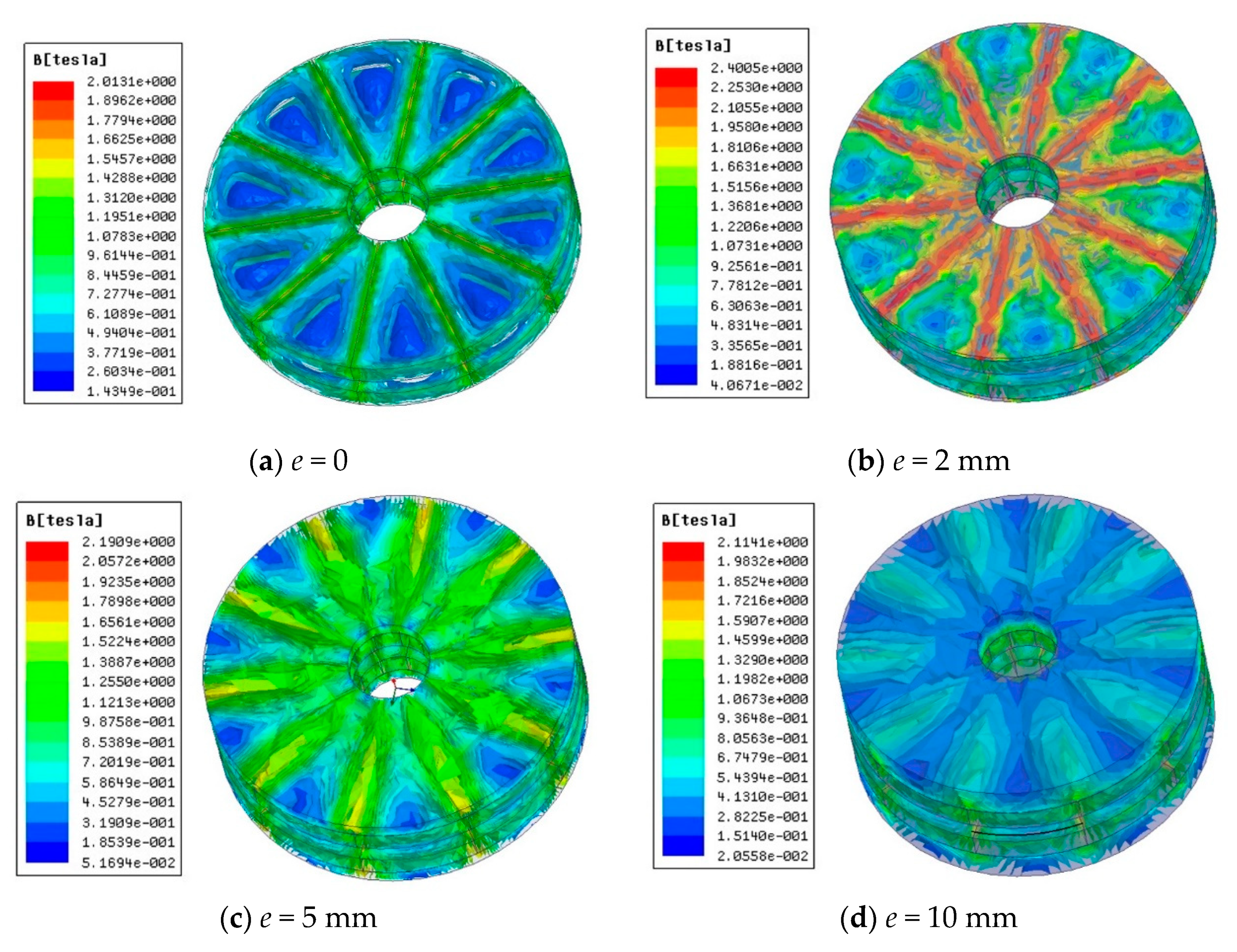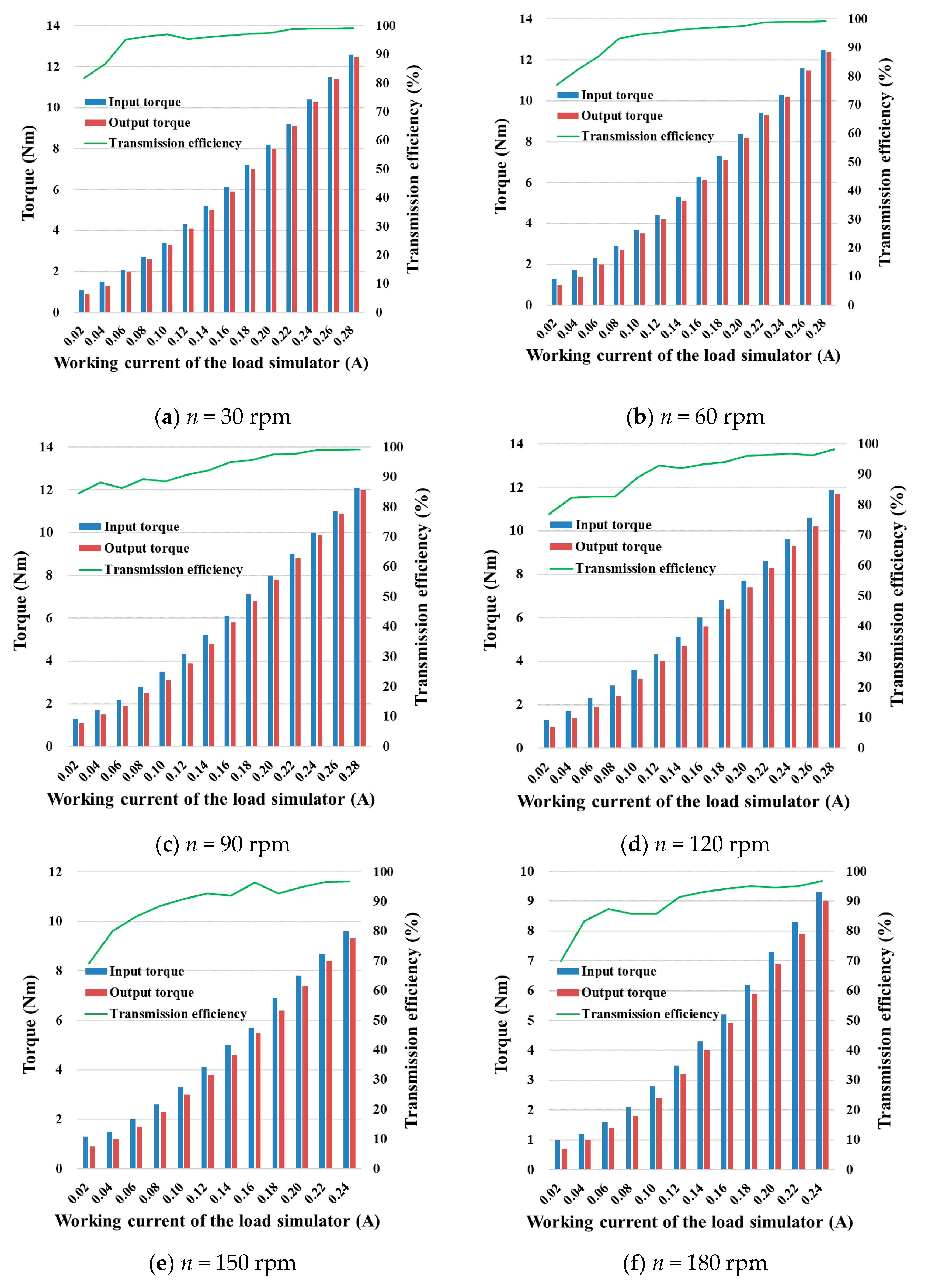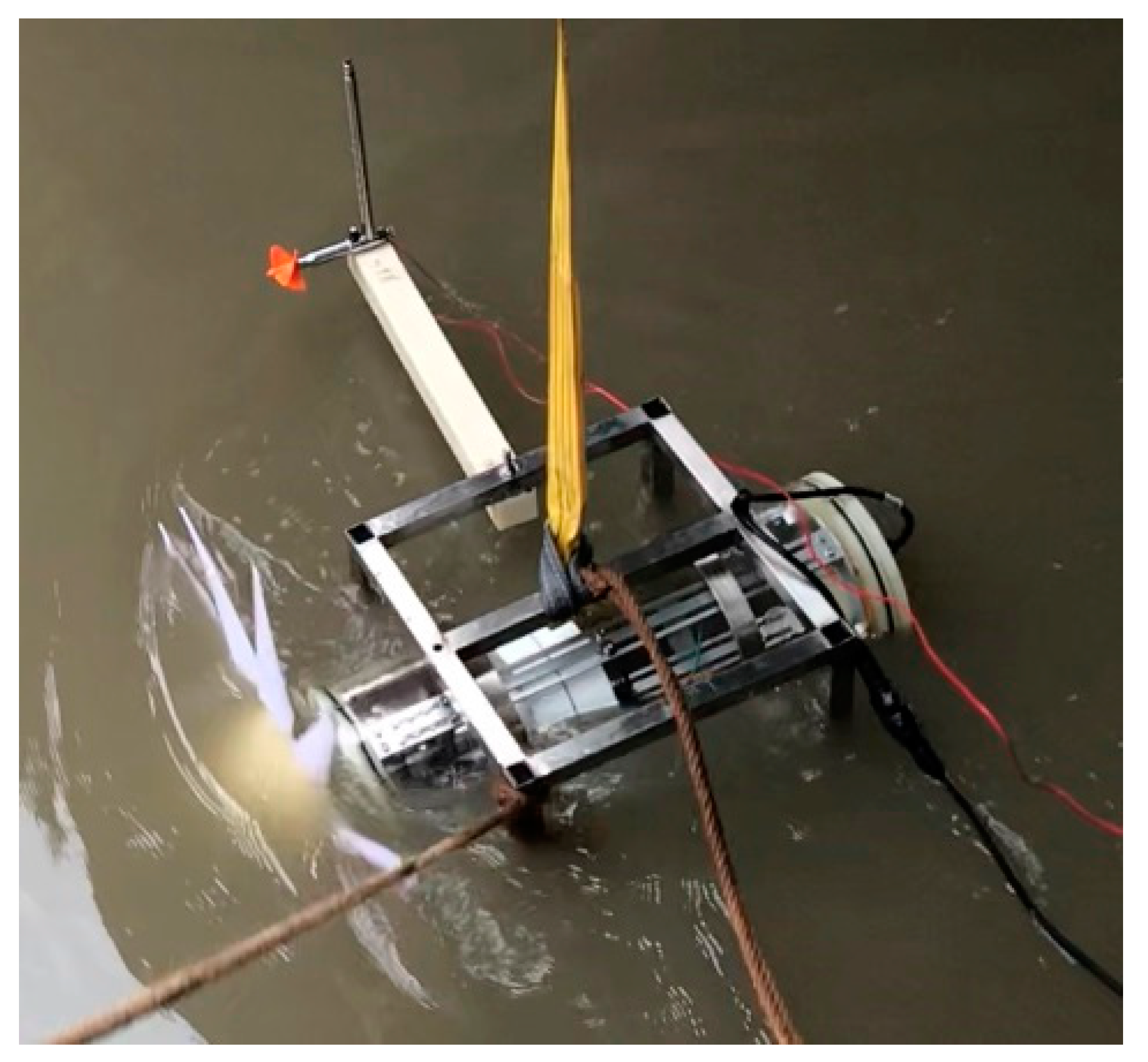Compact Low-Velocity Ocean Current Energy Harvester Using Magnetic Couplings for Long-Term Scientific Seafloor Observation
Abstract
:1. Introduction
2. LOCH Design and Parameter Optimization
2.1. Overall Design
2.2. Turbine Selection
2.3. Magnetic Coupling Structure
3. Magnetic Coupling Parameter Optimization
3.1. D FE Simulation Modeling
3.2. Pole Pairs
3.3. Magnet Thickness
3.4. Iron Yoke Thickness
3.5. Air-Gap Length
4. Magnetic Coupling Experiment
4.1. Experimental Platform Design
4.2. The Static Performance of The Magnetic Coupling
4.3. The Dynamic Performance of The Magnetic Coupling
5. LOCH Assembly and Experiment
5.1. Hydrostatic Seal Test
5.2. Underwater Test
6. Conclusions
Author Contributions
Funding
Conflicts of Interest
References
- Barnes, C.R.; Best, M.M.R.; Johnson, F.R.; Pautet, L.; Pirenne, B. Challenges, benefits, and opportunities in installing and operating cabled ocean observatories: Perspectives from NEPTUNE Canada. IEEE J. Ocean. Eng. 2013, 38, 144–157. [Google Scholar] [CrossRef]
- Lu, F.; Zhou, H.; Peng, X.; Yue, J.; Wang, P. Technical preparation and prototype development for long-term cabled seafloor observatories in Chinese marginal seas. In Seafloor Observatories: A New Vision of the Earth from the Abyss; Springer Praxis Books; Springer: Berlin/Heidelberg, Germany, 2015; pp. 503–529. [Google Scholar]
- Sandeep, D.N.; Kumar, V. Review on clustering, coverage and connectivity in underwater wireless sensor networks: A communication techniques perspective. IEEE Access 2017, 5, 11176–11199. [Google Scholar] [CrossRef]
- Bahaj, A.S. Generating electricity from the oceans. Renew. Sustain. Energy Rev. 2011, 15, 3399–3416. [Google Scholar] [CrossRef]
- Hussain, A.; Arif, S.M.; Aslam, M. Emerging renewable and sustainable energy technologies: State of the art. Renew. Sustain. Energy Rev. 2017, 71, 12–28. [Google Scholar] [CrossRef]
- Khan, N.; Kalair, A.; Abas, N.; Haider, A. Review of ocean tidal, wave and thermal energy technologies. Renew. Sustain. Energy Rev. 2017, 72, 590–604. [Google Scholar] [CrossRef]
- Melikoglu, M. Current status and future of ocean energy sources: A global review. Ocean Eng. 2018, 148, 563–573. [Google Scholar] [CrossRef]
- Schrader, P.S.; Reimers, C.E.; Girguis, P.; Delaney, J.; Doolan, C.; Wolf, M.; Green, D. Independent benthic microbial fuel cells powering sensors and acoustic communications with the MARS underwater observatory. J. Atmos. Ocean. Technol. 2016, 33, 607–617. [Google Scholar] [CrossRef]
- Ng, K.-W.; Lam, W.-H.; Ng, K.-C. 2002–2012: 10 years of research progress in horizontal-axis marine current turbines. Energies 2013, 6, 1497–1526. [Google Scholar] [CrossRef] [Green Version]
- Guney, M.S.; Kaygusuz, K. Hydrokinetic energy conversion systems: A technology status review. Renew. Sustain. Energy Rev. 2010, 14, 2996–3004. [Google Scholar] [CrossRef]
- Finkl, C.W.; Charlier, R. Electrical power generation from ocean currents in the Straits of Florida: Some environmental considerations. Renew. Sustain. Energy Rev. 2009, 13, 2597–2604. [Google Scholar] [CrossRef]
- Khan, M.J.; Bhuyan, G.; Iqbal, M.T.; Quaicoe, J.E. Hydrokinetic energy conversion systems and assessment of horizontal and vertical axis turbines for river and tidal applications: A technology status review. Appl. Energy 2009, 86, 1823–1835. [Google Scholar] [CrossRef]
- O’Rourke, F.; Boyle, F.; Reynolds, A. Marine current energy devices: Current status and possible future applications in Ireland. Renew. Sustain. Energy Rev. 2010, 14, 1026–1036. [Google Scholar] [CrossRef] [Green Version]
- Sen, Z. Energy generation possibility from ocean currents: Bosphorus, Istanbul. Ocean Eng. 2012, 50, 31–37. [Google Scholar] [CrossRef]
- Mutsuda, H.; Rahmawati, S.; Taniguchi, N.; Nakashima, T.; Doi, Y. Harvesting ocean energy with a small-scale tidal-current turbine and fish aggregating device in the Indonesian Archipelagos. Sustain. Energy Technol. Assess. 2019, 35, 160–171. [Google Scholar] [CrossRef]
- Zhou, Z.; Benbouzid, M.; Charpentier, J.-F.; Scuiller, F.; Tang, T. Developments in large marine current turbine technologies—A review. Renew. Sustain. Energy Rev. 2017, 71, 852–858. [Google Scholar] [CrossRef]
- Lankhorst, M.; Zenk, W. Lagrangian observations of the middepth and deep velocity fields of the northeastern Atlantic Ocean. J. Phys. Oceanogr. 2006, 36, 43–63. [Google Scholar] [CrossRef] [Green Version]
- Chang, Y.-C.; Chu, P.C.; Tseng, R.-S. Site selection of ocean current power generation from drifter measurements. Renew. Energy 2015, 80, 737–745. [Google Scholar] [CrossRef]
- Qi, C.; Lin, Y.; Zhao, J. Ocean current power generation at low flow velocity for oceanographic instruments. J. Mech. Electr. Eng. 2017, 34, 1055–1059. [Google Scholar] [CrossRef]
- Bahaj, A.S.; Molland, A.F.; Chaplin, J.R.; Batten, W.M.J. Power and thrust measurements of marine current turbines under various hydrodynamic flow conditions in a cavitation tunnel and a towing tank. Renew. Energy 2007, 32, 407–426. [Google Scholar] [CrossRef]
- Suzuki, T.; Mahfuz, H. Analysis of large-scale ocean current turbine blades using Fluid-Structure Interaction and blade element momentum theory. Ships Offshore Struct. 2018, 13, 451–458. [Google Scholar] [CrossRef]
- Mohammadi, S.; Hassanalian, M.; Arionfard, H.; Bakhtiyarov, S. Optimal design of hydrokinetic turbine for low-speed water flow in Golden Gate Strait. Renew. Energy 2020, 150, 147–155. [Google Scholar] [CrossRef]
- Li, Z.; Maki, N.; Ida, T.; Miki, M.; Izumi, M. Comparative study of 1-MW PM and HTS synchronous generators for marine current turbine. IEEE Trans. Appl. Supercond. 2018, 28, 1–5. [Google Scholar] [CrossRef]
- Goundar, J.N.; Ahmed, M.R. Marine current energy resource assessment and design of a marine current turbine for Fiji. Renew. Energy 2014, 65, 14–22. [Google Scholar] [CrossRef]
- Rahimian, M.; Walker, J.; Penesis, I. Performance of a horizontal axis marine current turbine—A comprehensive evaluation using experimental, numerical, and theoretical approaches. Energy 2018, 148, 965–976. [Google Scholar] [CrossRef]
- Tian, W.; Mao, Z.; Ding, H. Design, test and numerical simulation of a low-speed horizontal axis hydrokinetic turbine. Int. J. Nav. Archit. Ocean Eng. 2018, 10, 782–793. [Google Scholar] [CrossRef]
- Benelghali, S.; Benbouzid, M.E.H.; Charpentier, J.F. Generator systems for marine current turbine applications: a comparative study. IEEE J. Ocean. Eng. 2012, 37, 554–563. [Google Scholar] [CrossRef] [Green Version]
- Xu, M.; Zhang, X.; Zhu, W.; Dong, Y.; Guo, J. The study of miniaturization electrical energy supplement for the independent power supply marine monitoring instrument. Acta Energ. Sol. Sin. 2013, 34, 2045–2050. [Google Scholar] [CrossRef]
- Tian, Y.; Yuan, R.; Li, X.; Chen, G. Design and test of under deep sea micro-flow power generation system. Acta Energ. Sol. Sin. 2018, 39, 873–878. [Google Scholar]
- Chikaura, H.; Oka, Y.; Nakashima, Y.; Nakanishi, Y. Development of a new type of seal system for use in ocean current or tidal power generation. In Proceedings of the 16th International Power Electronics and Motion Control Conference and Exposition, Antalya, Turkey, 21–24 September 2014; pp. 828–832. [Google Scholar]
- Li, J.; Mi, Z.; Lv, F.; Wang, K. Research on airfoil improvement of current generation devices. Fluid Power Transm. Control 2017, 03, 20–23. [Google Scholar] [CrossRef]





















| Reference | Radius of The Turbine (m) | Current Velocity (m/s) | Output Power (W) | Overall Efficiency (%) |
|---|---|---|---|---|
| [19] | 1.1 | 1.0 | 500 | 64 |
| [26] | 0.6 | 0.25 | - | - |
| [28] | 0.18 | 0.16 | 0.08 | 40 |
| [29] | 1.0 | 0.1 | 0.3 | 39 |
| This paper | 0.3 | 0.4 | 2.8 | 75 |
| Parameter | Value |
|---|---|
| Radius r | 0.3 m |
| Rated flow velocity vr | 1.0 m/s |
| Rated input power Prin | 58 W |
| Lowest flow velocity vmin | 0.4 m/s |
| Input energy at the lowest flow velocity Pin | 3.6 W |
| Number of blades B | 12 |
| Tip speed ratio λ | 3 |
| Power coefficient Cp | 0.4 |
| Parameter | Value |
|---|---|
| Material of magnet | Nd-Fe-B |
| Remanence of the magnet Br | 1.25 T |
| Outer radius of the magnet | 54 mm |
| Inner radius of the magnet | 12 mm |
| Magnet thickness h | 8 mm |
| Pole pairs p | 5 |
| Air-gap length a | 10 mm |
| Iron yoke thickness e | 5 mm |
| Isolation layer thickness | 4 mm |
| Radius of The Turbine (m) | The Output Power at 0.3 m/s (The Lowest Flow Velocity) (W) | The Output Power at 1.0 m/s (The Rated Flow Velocity) (W) |
|---|---|---|
| 0.3 | 2.8 | 43.5 |
| 0.6 | 11.1 | 173.9 |
| 0.9 | 25.0 | 391.2 |
© 2020 by the authors. Licensee MDPI, Basel, Switzerland. This article is an open access article distributed under the terms and conditions of the Creative Commons Attribution (CC BY) license (http://creativecommons.org/licenses/by/4.0/).
Share and Cite
Huang, L.; Lyu, F. Compact Low-Velocity Ocean Current Energy Harvester Using Magnetic Couplings for Long-Term Scientific Seafloor Observation. J. Mar. Sci. Eng. 2020, 8, 410. https://doi.org/10.3390/jmse8060410
Huang L, Lyu F. Compact Low-Velocity Ocean Current Energy Harvester Using Magnetic Couplings for Long-Term Scientific Seafloor Observation. Journal of Marine Science and Engineering. 2020; 8(6):410. https://doi.org/10.3390/jmse8060410
Chicago/Turabian StyleHuang, Longxiang, and Feng Lyu. 2020. "Compact Low-Velocity Ocean Current Energy Harvester Using Magnetic Couplings for Long-Term Scientific Seafloor Observation" Journal of Marine Science and Engineering 8, no. 6: 410. https://doi.org/10.3390/jmse8060410
APA StyleHuang, L., & Lyu, F. (2020). Compact Low-Velocity Ocean Current Energy Harvester Using Magnetic Couplings for Long-Term Scientific Seafloor Observation. Journal of Marine Science and Engineering, 8(6), 410. https://doi.org/10.3390/jmse8060410





